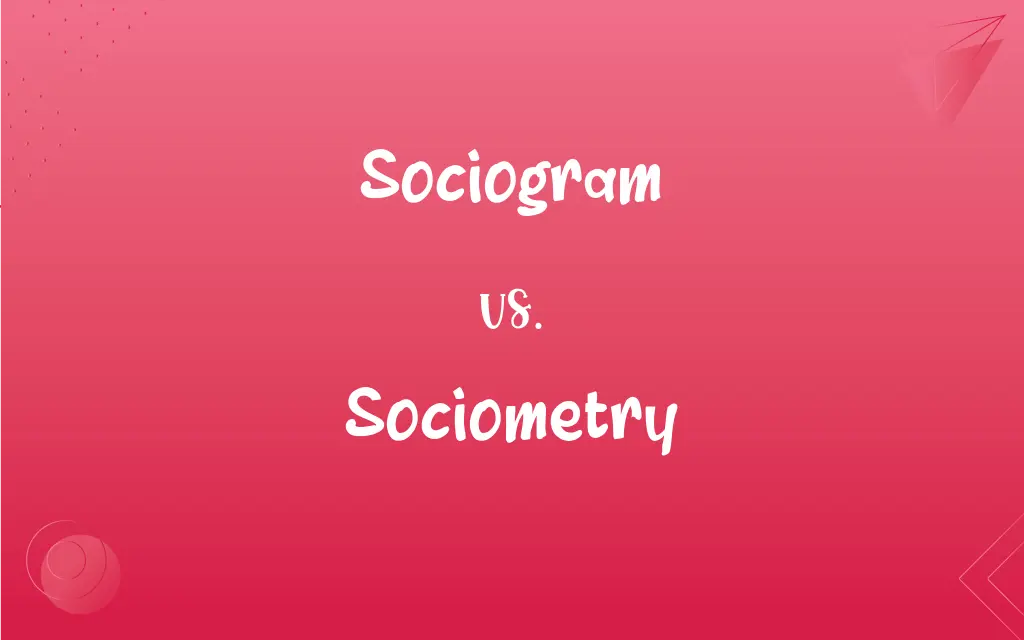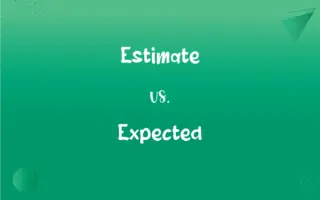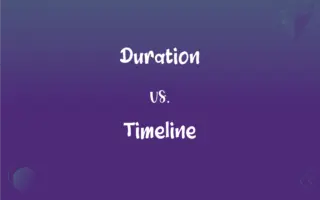Sociogram vs. Sociometry: What's the Difference?
Edited by Aimie Carlson || By Harlon Moss || Updated on November 7, 2023
A sociogram is a visual representation of social links in a group; sociometry is the method of measuring those relationships.

Key Differences
A sociogram is a graphical tool, depicting the relationships between individuals within a group, often using lines or symbols. Sociometry, conversely, refers to the quantitative method of analyzing the social relationships that the sociogram visually represents.
In a sociogram, the focus is on the visualization of social dynamics, such as friendships or social distances. Sociometry involves the study and measurement of these dynamics, potentially through surveys or observational data.
Sociograms are useful for immediately identifying social configurations like cliques within a group, while sociometry provides the systematic approach to understand the intensity and reciprocity of these social connections.
While a sociogram can be seen as the product or outcome of sociometric research, sociometry itself encompasses a broader range of techniques and analyses beyond mere visual representation.
Sociograms are limited to the graphical domain, often used by educators and psychologists, whereas sociometry can include numerical scores and indices reflecting the strength of social ties.
ADVERTISEMENT
Comparison Chart
Definition
Visual map of social relationships
Methodology for measuring social relationships
Focus
Visualization
Measurement and analysis
Form
Graphical
Quantitative and qualitative
Purpose
To illustrate
To investigate and quantify
Use Case
Immediate understanding of group dynamics
Systematic study of interpersonal relationships
ADVERTISEMENT
Sociogram and Sociometry Definitions
Sociogram
A chart showing the social connections in a group.
The teacher used a sociogram to view the friendship patterns in her class.
Sociometry
The study of interpersonal relationships within a group.
Through sociometry, the counselor assessed the cohesion of the group.
Sociogram
A diagram that illustrates social ties.
A sociogram was drawn to identify potential bullying relationships.
Sociometry
A quantitative approach to social relationship analysis.
Sociometry was used to measure the social distances between employees.
Sociogram
A visual analysis of group dynamics.
The sociogram highlighted the most influential members of the team.
Sociometry
The science of measuring social compatibility.
Sociometry revealed the pairings of roommates with the highest compatibility.
Sociogram
A graphic representation of social interactions.
The sociogram showed an isolated cluster separate from the main group.
Sociometry
A technique to evaluate social preferences and structures.
Sociometry was applied to determine the flow of communication within the department.
Sociogram
A visual tool for mapping social links.
The sociogram revealed who the central figures were in the social network.
Sociometry
A method for identifying social leaders and isolates.
Sociometry helped to pinpoint the informal leadership structure in the office.
Sociogram
A graphic representation of the structure of interpersonal relations in a group situation; a depiction of the social links that a person has.
Sociometry
The quantitative study of interpersonal relationships in populations, especially the study and measurement of preferences.
Sociometry
The quantitative study of social interactions, and the measurement of preferences etc.
Sociometry
The quantitative study of social relationships
FAQs
What is a sociogram used for?
It's used to visualize social relationships within a group.
Can a sociogram show who is popular in a group?
Yes, it can indicate popularity through the number of connections.
What does sociometry measure?
It measures the nature and strength of relationships in a group.
Who invented sociometry?
Jacob L. Moreno developed the field in the early 20th century.
Is sociometry only about counting friends?
No, it assesses various aspects of social relationships.
How are sociograms created?
They are created based on data from sociometric surveys or observations.
Is sociometry subjective?
It's based on empirical data, so it aims to be objective.
Can sociograms help in conflict resolution?
Yes, by visually identifying the sources of conflict in social dynamics.
Does sociometry involve statistics?
Yes, statistical analysis is often used in sociometric studies.
Are sociograms still relevant?
They are, especially in educational and psychological contexts.
What's the difference between a sociogram and a social network diagram?
A sociogram is a type of social network diagram focused on a specific group.
Are sociograms quantitative or qualitative?
They are qualitative visual representations of quantitative data.
Do sociograms only show positive relationships?
No, they can also depict negative or conflictual relationships.
What symbols are used in a sociogram?
Circles for individuals, lines for relationships, and arrows for directionality.
What does a thick line in a sociogram mean?
It usually represents a strong or significant relationship.
Is there software for creating sociograms?
Yes, there are several software programs designed for this purpose.
Are sociograms easy to interpret?
They can be, but it depends on the complexity of the group's relationships.
Can sociometry be used in business?
Yes, it's used for team building and organizational analysis.
Can sociometry predict behavior?
To some extent, it can forecast group dynamics and individual roles.
Can sociometry improve group function?
Yes, by understanding and addressing relational dynamics.
About Author
Written by
Harlon MossHarlon is a seasoned quality moderator and accomplished content writer for Difference Wiki. An alumnus of the prestigious University of California, he earned his degree in Computer Science. Leveraging his academic background, Harlon brings a meticulous and informed perspective to his work, ensuring content accuracy and excellence.
Edited by
Aimie CarlsonAimie Carlson, holding a master's degree in English literature, is a fervent English language enthusiast. She lends her writing talents to Difference Wiki, a prominent website that specializes in comparisons, offering readers insightful analyses that both captivate and inform.































































